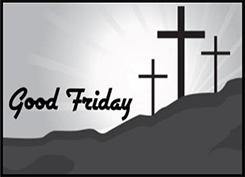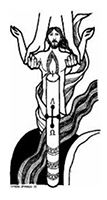Holy Week / Easter Services explained
THE MASS OF CHRISM
The blessing of oil is very ancient – there is documented evidence of this liturgy from the fourth century, but it is certainly of earlier origin. On this day the People of God, bishops, priests, deacons and the lay faithful, assemble at the cathedral for the Chrism Mass with the Bishop as the main concelebrant. There is a long standing tradition that it takes place on the morning of Maundy Thursday, where the bishop is surrounded by the priests of his diocese, whose presence demonstrates their unity with him. Maundy Thursday is the day on which both the Mass and the priesthood were instituted. Pope Paul VI introduced the renewal of the priestly commitment into the liturgy. This is followed by the blessing of oils and the consecration of Chrism. In some Diocese it is not convenient for all clergy to assemble at the cathedral and then return to their parishes in time for the Mass of the Last Supper; hence the Chrism Mass is often celebrated on the Tuesday of Holy Week.

The Oil of the Sick and the Oil of Catechumens are plain olive oil – the Oil of Chrism is perfumed with balsam.
The Oil of the Sick is blessed with the bishop praying: ‘May your blessing come upon all who are anointed with this oil, that they may be freed from pain and illness and made well again in body, mind and soul’.
Then the Oil of Catechumens is blessed while he says: ‘give wisdom and strength to all who are anointed with it in preparation for their baptism’.
Finally, the Oil of Chrism is brought forward and the bishop breathes on this oil to invoke the Holy Spirit and consecrates it praying: ‘make this mixture of oil and perfume a sign and source of your blessing. Pour out the gifts of your Holy Spirit on our brothers and sisters who will be anointed with it. Let the splendour of holiness shine on the world from every place and thing signed by this oil’. After the Mass, the parish oil stocks are filled and taken back by priests to their parishes. They are then presented in each parish at the Mass of the Lord’s Supper on Maundy Thursday evening.
Maundy Thursday (Holy Thursday)
Maundy Thursday, also known as “Holy Thursday” is the day before Good Friday. Maundy Thursday is the name given to the day on which Jesus celebrated the Passover with His disciples, known as the Last Supper. Two important events are the focus of Maundy Thursday.

First, Jesus celebrated the Last Supper with His disciples and thereby instituted the Lord’s Supper; the first Mass. Second, Jesus washed the disciples’ feet as an act of humility and service, thereby setting an example that we should love and serve one another in humility (John 13:3-17). In most Catholic churches, there is a foot-washing ceremony to commemorate Jesus’ washing the feet of the disciples. The word “Maundy” is derived from the Latin word for “command.” The “Maundy” in Maundy Thursday refers to the command Jesus gave to the disciples at the Last Supper, that they should love and serve one another. In this way he instituted the priesthood.
During the Mass the bells are rung at the Gloria and then remain silent until Easter. After the Mass the remaining hosts are removed to a separate place and the sanctuary of the church left bare as a reminder of Christ’s Passion and death, and the fact that He is no longer in the church. Hence, the Blessed Sacrament is carried in procession to an altar of repose, where the congregation are invited to remain in private prayer until midnight.
When the priest returns to the sanctuary he leads the traditional stripping of the altar (during which psalms are recited). Evening prayer is recited at midnight and the Blessed Sacrament reposed.
Good Friday
According to the Church’s ancient tradition, the sacraments are not celebrated on Good Friday. “Celebration of the Lord’s Passion,” traditionally known as the “Mass of the Presanctified,” (although it is not really a Mass) is usually celebrated at 3-00pm. The altar is completely bare, with no cloths, candles nor cross. The service is divided into three parts: Liturgy of the Word, Veneration of the Cross and Holy Communion. The priest and deacons wear red or black vestments. The liturgy starts with the priests and deacons going to the altar in silence and prostrating themselves for a few moments in silent prayer, then an introductory prayer is prayed.

In part one, the Liturgy of the Word, we hear the most famous of the Suffering Servant passages from Isaiah (52:13-53:12), a pre-figurement of Christ on Good Friday.
Psalm 30 is the Psalm “Father, I put my life in your hands.”
The Second Reading, or Epistle, is from the letter to the Hebrews, 4:14-16; 5:7-9. The Gospel Reading is the Passion of St. John.
The General Intercessions (Bidding Prayers for the needs of the Church and the world) conclude the Liturgy of the Word.
Part two is the Veneration of the Cross. A veiled cross is carried from the back of the Church, and then venerated by the congregation. We joyfully venerate and kiss the wooden cross “on which hung the Saviour of the world.”
Part three, Holy Communion, concludes the Celebration of the Lord’s Passion. The altar is covered with a cloth and the ciborium containing the Blessed Sacrament are brought to the altar from the Altar of Repose. The Our Father and the Ecce Agnus Dei (“This is the Lamb of God”) are recited. The people receive Holy Communion, there is a “Prayer After Communion,” and then a “Prayer Over the People,” and everyone departs in silence.
Holy Saturday
On Holy Saturday the Church waits at the Lord’s tomb, meditating on his suffering and death. The altar is left bare, and the sacrifice of the Mass is not celebrated. Only after the solemn vigil during the night, held in anticipation of the resurrection, does the Easter celebration begin, with a spirit of joy that overflows into the following period of fifty days.
The atmosphere in the church is different: the holy water fonts are drained, all the lights are out, the tabernacle is empty. The Vigil Service begins in the evening usually outside in the church garden. A new fire is lit and blessed.
1) Blessing of the fire and the Pascal candle.
 A Paschal Candle is then prepared with these words while the priest marks the candle:
A Paschal Candle is then prepared with these words while the priest marks the candle:
Christ yesterday and today, the Beginning and the end, Alpha, and Omega all time belongs to him, and all the ages, to him be glory and power through every age for ever. Amen
The priest lights the candle from the new fire, saying:
May the light of Christ, rising in glory, dispel the darkness of our hearts and minds.
The candle is then processed into the church which is in darkness with the priest singing “Christ our light” (Lumen Christi) and the congregation sings in reply: “Thanks be to God” (Deo gratias). Everyone lights their candle from the Easter candle and continue in procession until the whole church is alight. The Paschal candle symbolizes Christ, the Light of the World.
Next follows the glorious Easter song of the Catholic Church: the Exultet (Easter proclamation). This magnificent hymn, which is remarkable for its lyric beauty and profound symbolism, announces the dignity and meaning of the mystery of Easter; it tells of man’s sin, of God’s mercy, and of the great love of the Redeemer for mankind, admonishing us in turn to thank the Trinity for all the graces that have been lavished upon us.
2) Liturgy of the Word
During the Easter vigil, nine readings are provided. The readings tell (among others) the story of creation, Abraham and Isaac and the Crossing of the Red Sea. The Gloria is sung before the reading of the Epistle of the Romans, and the Alleluia is sung before the Gospel.
3) Liturgy of Baptism
 During this time the Easter water is blessed and new members are brought into the Church through baptism, and the faithful are blessed with water and renew their baptismal promises.
During this time the Easter water is blessed and new members are brought into the Church through baptism, and the faithful are blessed with water and renew their baptismal promises.
4) Liturgy of Eucharist
The Mass resumes. The whole church is called to join at the sacrificial table that Christ prepared for us through his death and resurrection. The Mass ends with the glorious: “The Mass is ended, go in peace, alleluia, alleluia. R. Thanks be to God, alleluia, alleluia”